My shopping cart
Your cart is currently empty.
Continue Shopping
There are a lot of dips, sauces and pastes in Thai cuisine, and that does not include the seasoning sauces or pastes for cooking.
Now we will give you a guideline for Thai dipping sauces and chili pastes.
There are two words in Thai that commonly refer to dipping sauces and chili pastes.
The first one is “Nam Jim” meaning "dipping sauce" and second is “Nam Phrik” meaning “chili paste”. Both are a general term and indicate to a wide variety of dipping sauces and pastes in Thai cuisine.
Depending on ingredients and the region, Nam Jim and Nam Phrik may vary in texture, consistency and tastes - spicy, sweet, salty, sour, savory or mixed. The main difference for these two is Nam Jim tends to have more watery consistency than Nam Phrik. Also, one of key ingredients of Nam Phrik is chilies (Phrik means chili in Thai and is where the name comes from) which fresh or dried chilies are pounded or ground with other spices to make a paste.
Nam Jim does not necessary to have chilies in it and not always spicy.
Both Nam Jim and Nam Phrik are normally served on small saucers placed by the main dish as a condiment or dip for bland foods like raw or boiled vegetables, fish, poultry and meats.
There are no specific rules, but Thai people typically serve Nam Jim with grilled or streamed meats and seafood. While Nam Phrik is popularly paired with raw or boiled vegetables.
If you want to try some Thai dipping sauces or chili pastes and are not sure where to start.
Here are some popular Nam Jim and Nam Phrik in Thailand.
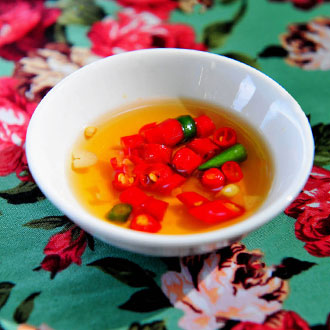
This is one of the most versatile table condiments for Thai people. You will find it in almost every restaurant in Thailand.
If you don’t see it on the table, you can ask for it and the chef or waiter will bring it to you in no time.
Phrik Nam Pla (or Nam Pla Phrik is the same) means chilies in fish sauce, which indicate the two key ingredients of this sauce, simple but very satisfying.
It can be eaten with almost every Thai dish. Some might add extra chopped garlic, lime juice or coriander leaves to the sauce.

Literally means ‘dipping sauce for chicken’. It indicates that the sauce was created to accompany fried or grilled chicken, however, the sauce is very versatile, you can use it for many dishes, mostly deep fried or grilled meats, seafood, dim sum, and spring rolls.
Nam Jim Gai with the consistency of a thick syrup contains medium spicy and very sweet taste, normally referred to as "sweet Thai chili sauce" in English. It is usually made with chilies, garlic, sugar, vinegar, salt and tapioca starch or corn starch.
Besides using it as a generic chili sauce for fried dishes, it can be used as the base of other types of sauces, such as Nam Jim Thod Man Pla (dipping sauce for deep-fried fish cakes).
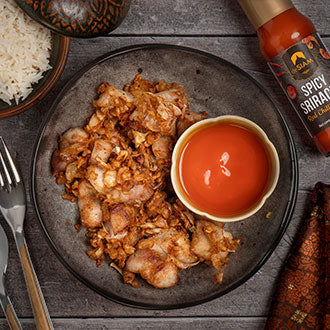
It is called Sauce Phrik in Thai and a useful ingredient for Thai cooking. Sriracha sauce is a very good example for this type of Thai chili sauce.
The common recipe for this sauce is chili peppers, distilled vinegar, garlic, sugar, and salt. The Thai style hot sauce has several levels of spiciness and sourness depending on the brands.
It can be used in cooking like stir-fried dishes or soups, but commonly used as a dipping sauce, especially with Thai style omelet or deep-fried dishes.

It is a peanut sauce eaten with Thai Satay skewers. It is usually made of ground roasted peanuts, garlic, dark soy sauce, brown sugar, fish sauce, tamarind paste, Thai curry paste and coconut milk.
The western version normally uses peanut butter, which can be substituted for the ground peanuts, but the whole peanut would give richer, more satisfying flavor and aroma.
In Thailand, Nam Jim Satay is usually served with another condiment called “Archad” which consists of fresh chopped cucumber, spring onion and chili, mixed with vinegar.

This sauce originated from the Northeast of Thailand (or Isaan), but popularly nationwide just like Som Tam and Larb dishes.
It is a mixture of fish sauce, lime juice or tamarind juice, palm sugar, chopped shallots and ground dry-roasted white rice.
This sauce is good for any kind of grilled or roasted meats, from grilled pork or beef, BBQ chicken, roasted pork belly or grilled fish.
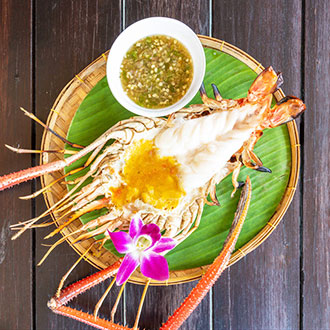
This seafood dipping sauce is another popular spicy sauces in Thailand. As the name indicates, it is usually served with grilled or steamed seafood.
It is created from a mixture of fish sauce, lime juice, sugar, chopped garlic and chilies. It is similar to Phrik Nam Pla, but Nam Jim Talay’s taste is usually sourer, spicier and more garlic.
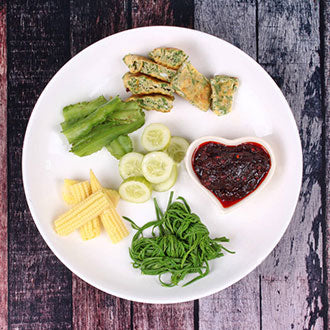
Another universal and classic chili paste widely used in Thai cuisine. It is made from roasted chilies, tamarind, fermented shrimp, shallots, galangal, and ginger and palm sugar.
The paste is medium spicy and sweet. Commonly used in the famous Tom Yam soup, stir-fried dishes like cashew with chicken, salad dressing, a spread on toast or sandwich and as a generic dip.
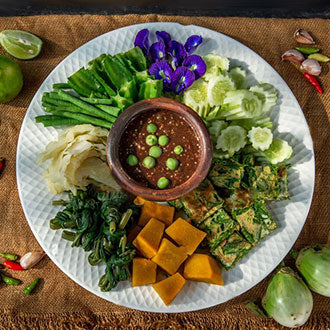
One of the most beloved chili dips in Thailand. But for those who are not familiar with fermented shrimp paste may find it taste too strong with pungent smell.
The chili dip is also spicy by default. It is usually made with fermented shrimp paste, lime, chilies, and pea eggplant.
Typically served with fried short mackerel and boiled vegetables, among other dishes.
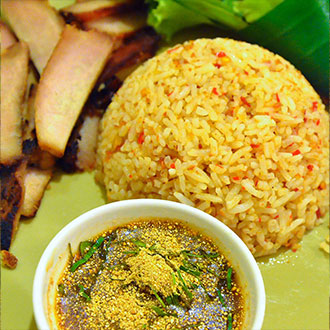
It literally translates to "chili paste from hell" so you cannot expect mild spiciness from this paste. It is made with dried chilies, shrimp paste, catfish, shallots, garlic, fish sauce and sugar.
The dip is normally eaten with steamed rice, boiled vegetables, grilled or fried meat, and crispy pork rinds to make it less spicy.
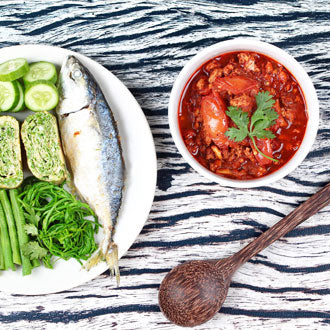
The famous chili dip from the North of Thailand that is loved by everyone. It is called Nam Phrik, but this is probably the mildest chili paste of all.
Commonly made with minced pork, chili paste, and tomatoes, which is the main ingredient that gives it its red look, but not its spiciness.
It is a combination of salty, sweet, and slightly sour flavors. Usually served with sticky rice and seasonal vegetables.

It is a well-known southern dish, mostly made with green Thai chili peppers, garlic, shrimp paste, fish sauce, lime juice, palm sugar and the smoked shrimp or prawns.
Its taste is a mix of sweet, sour, and salty taste with a unique smell of grilled smoked shrimp.
This dip is usually served with fresh or soft-boiled vegetables.